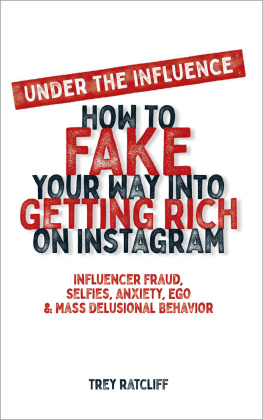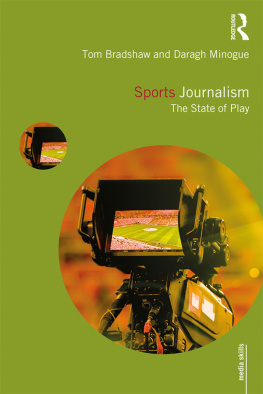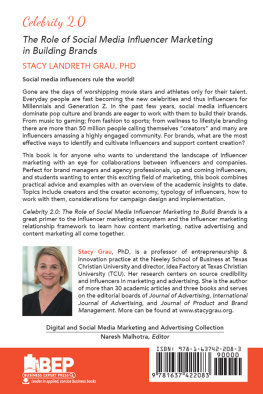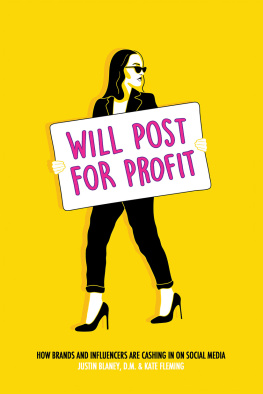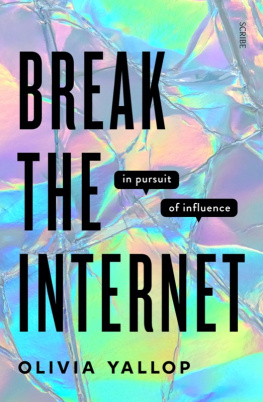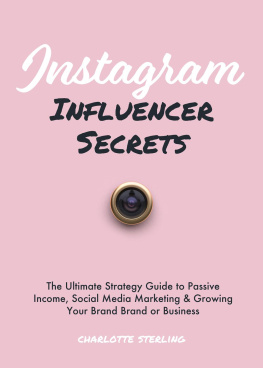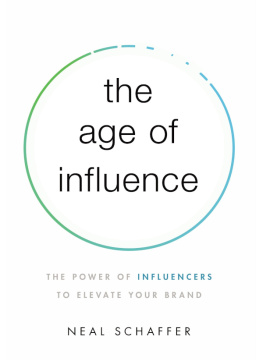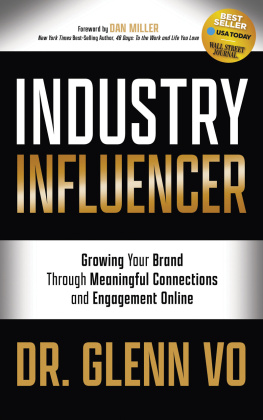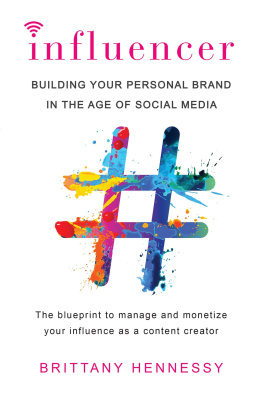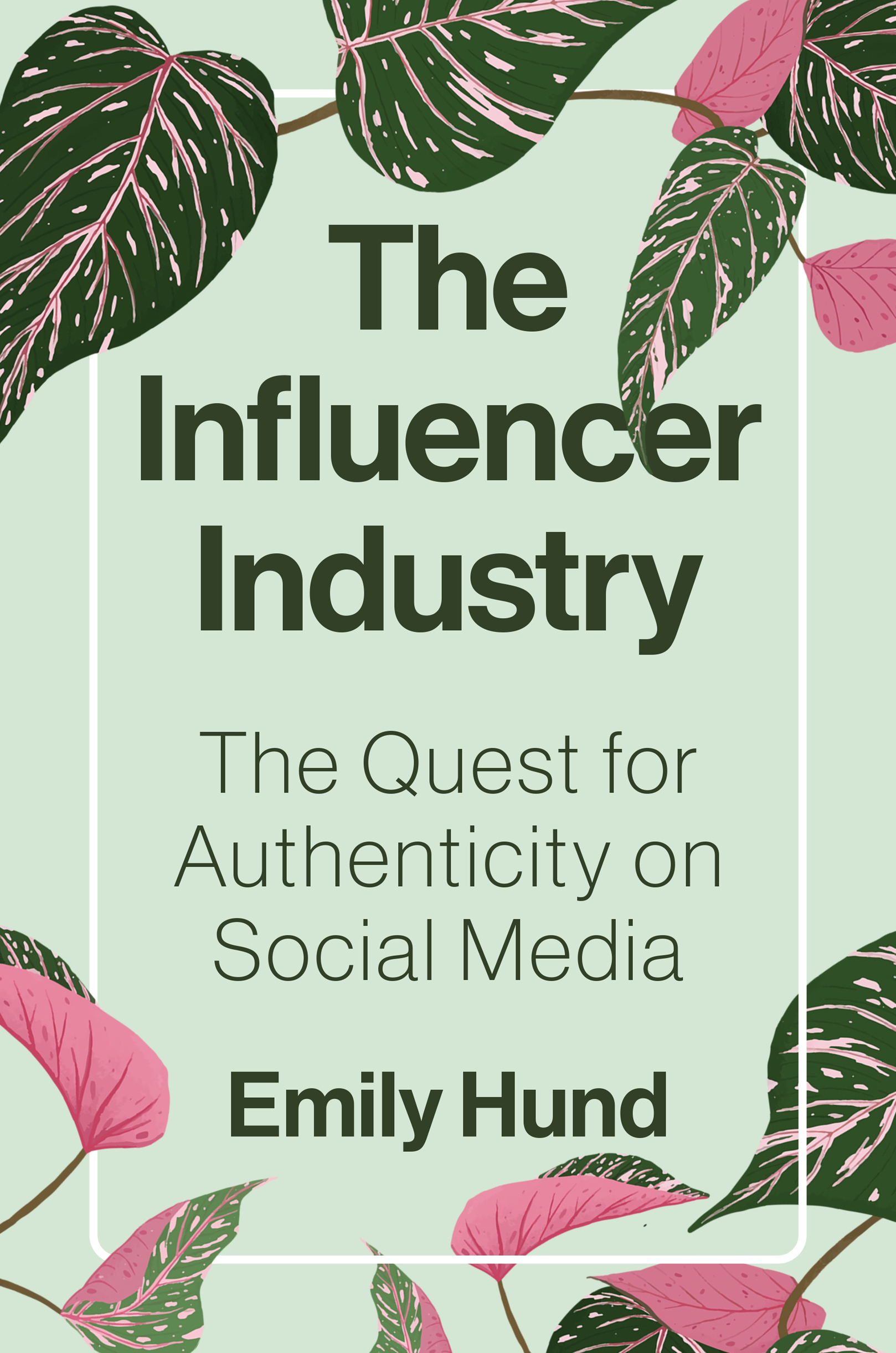The Influencer Industry
The Influencer Industry
The Quest for Authenticity on Social Media
Emily Hund
PRINCETON UNIVERSITY PRESS
PRINCETON AND OXFORD
Copyright 2023 by Emily Hund
Princeton University Press is committed to the protection of copyright and the intellectual property our authors entrust to us. Copyright promotes the progress and integrity of knowledge. Thank you for supporting free speech and the global exchange of ideas by purchasing an authorized edition of this book. If you wish to reproduce or distribute any part of it in any form, please obtain permission.
Requests for permission to reproduce material from this work
should be sent to
Published by Princeton University Press
41 William Street, Princeton, New Jersey 08540
99 Banbury Road, Oxford OX2 6JX
press.princeton.edu
All Rights Reserved
ISBN 978-0-691-23102-0
ISBN (e-book) 978-0-691-23407-6
Version 1.0
British Library Cataloging-in-Publication Data is available
Editorial: Meagan Levinson and Jacqueline Delaney
Production Editorial: Jill Harris
Text Design: Heather Hansen
Jacket Design: Heather Hansen
Production: Erin Suydam
Publicity: Maria Whelan and Kathryn Stevens
Copyeditor: Leah Caldwell
Jacket illustration: Calathea plant botanical illustration by Aum / rawpixel
For my family
Contents
- ix
- xi
- 173
Illustrations
Instagram image of Blair Eadie featuring LikeToKnowIt links
Instagram image of Socality Barbie
Instagram image of the Museum of Ice Creams sprinkle pool
The Instagram bio of CGI influencer Lil Miquela
An Instagram feed post by Sharon McMahon
An excerpt from an Instagram Story by Sharon McMahon
Acknowledgments
There are few things more overwhelming than pausing to consider the many people and events that made the completion of a book possible, especially when that book, from seed of an idea to finished manuscript, took the better part of a decade.
All of the formal work for this manuscript occurred while I have been a part of the Annenberg School for Communication at the University of Pennsylvania, first as a doctoral student and then as a fellow and affiliate at the Center on Digital Culture and Society. The support of ASCs faculty and staff has been instrumental to the books journey, as well as mine. My PhD adviser Joseph Turow has been a dependable source of encouragement, thoughtful questions, and puns, fundamentally shaping my thinking along the way. Feedback from Barbie Zelizer and Victor Pickard gave me the perspective I needed to imagine what this book project could be. Guobin Yang and CDCS pulled me out of a postpartum pandemic fog and provided the financial and moral support to write this manuscript. I cannot thank them all enough.
Over the years I have been lucky to collaborate on other research projects with brilliant and kind people from whom I have learned so much. Brooke Duffy took a chance on me when I was a first-year student and she was a new professor. We were complete strangersalbeit strangers whose educational and professional trajectories had uncanny similaritiesbut immediately got to work. Without her tremendous generosity as a collaborator, mentor, and friend, I would not be where I am today. In separate projects, Caitlin Petre and Lee McGuigan widened my perspective in important wayswith the added bonus of having fun working together.
My deepest thanks to the bloggers, influencers, and content creators who shared your stories, goals, and challenges with me, and to the marketers, brand representatives, talent managers, trend forecasters, and other influencer industry professionals who offered your expertise, reflections, and questions. I am so grateful to each one of you for your time and your willingness to help analyze this world as you navigated it yourselves. Thanks especially to Sharon McMahon, Blair Eadie, Darby Cisneros, and the Museum of Ice Cream for allowing me to use your Instagram images in this book.
Meagan Levinson and the team at Princeton University Press have been enthusiastic, thoughtful, and supportive from our first email exchange, and I am so glad to have worked with them to bring this book to the world. I sincerely appreciate the anonymous reviewers who provided insightful and good-faith feedback on the proposal and first draft of the manuscript. Laura Portwood-Stacer provided vital advice about the publishing process and helped me get started on this path.
A wise person once said that behind every successful woman is a group text hyping her up, and I would like to confirm here that this is trueperhaps more than ever during a pandemic. The in-person and digital support of the Hive MindElena Maris, Rosie Clark-Parsons, and my office mate of six years Samantha Oliverhas been essential in confronting the idiosyncrasies, struggles, and excitement of pursuing this work. I also rely on the support and laughs provided by the PSU BestiesAshley, Christa, Elyse, Emily, Stephand my oldest friend Amy. I am lucky to have friends who are truly the realest.
This book is ultimately for, and made possible by, my family. For my husband Henry, first and foremost, who has supported me unconditionally since we were teenagers and is the most involved and devoted father and partner one could ask for. For our sons, whose births brought highs and lows we did not know were possible and put everything in perspective. For my parents and in-laws, who have helped with childcare and provided moral support throughout. My mom, in particular, encouraged (some might say nagged) me to pursue graduate education when I wasnt sure if it was time to make the leap, and has provided piles of relevant magazine and newspaper clippings over the years. For my sisters, sisters-in-law, and brothers-in-law, whose support and pride I deeply appreciate. For all four of my grandparents, whose amazing and steadfast presence in my life has shaped it profoundly, and my great-grandparents, whose immense sacrifices and extremely limited access to, in some cases, even the most basic education, I carry with me always. For these reasons and many more, I hope to always be a steward of the wonderful opportunities I have.
The Influencer Industry
Introduction
Staring out from the cover of New York magazines September 2019 issue was a close-up of a young womans face, wide-eyed with a resigned can you believe this? expression, covered in red rubber darts. The cover line read, What Instagram did to me. Readers familiar with the fashion blogosphere of the 2000s or New York Citys arts or media scenes in the 2010s would recognize the face as that of Tavi Gevinson, who first made a name for herself in the late 2000s as a preteen style blogger. Her rise had been nervously and obsessively tracked by blog readers, journalists, and industry insiders. In the span of a few short years, Gevinson reaped enormous rewards from being an early entrant into the world of social media self-branding: from taking selfies to being photographed by Annie Leibovitz; from attending middle school to sitting front row at Fashion Week (and famously pissing off a Grazia editor by blocking the view with an enormous hair bow); from hanging out in the comments section of her blog to running her own digital teen magazine with the blessing of legendary editor Jane Pratt and radio producer Ira Glass. But by the time of this 2019 cover story, Gevinson, then aged twenty-three, had also been through the wringer. She had been a test case, patient zero, for the influencer industrial ethos: the idea that anyone can cultivate a loyal audience by providing consistent and relatable content on social media, and then use that audiences likes, follows, and other engagement metrics as evidence of influence to be leveraged for a range of social and economic rewardsmany of them accessible through partnering with commercial brands to entwine their messages with ones own.



